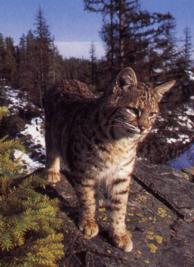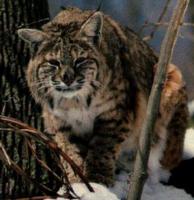

Genus: Felis
Species: rufus

The large coniferous forest found in Canada is called the Taiga. There are many swamps, mountains and forests in the Taiga that are home to the Bobcat. Throughout much of the United States the bobcat lives in forests, but can also be found in desserts and chaparral.
A bobcat's body is about two feet long, and its tail is approximately four to eight inches long. The bobcat gets its name from it's stubby tail. A bobcat's weight range is between thirteen and twenty three pounds. It stands twenty to twenty four inches tall. A bobcat's paw print is a little over an inch wide.
The bobcat has two color changes per year. The fur of the bobcat is striped, blotchy, and dense; tawny gray for the winter and reddish brown for the summer. The baby bobcat has spotted fur that disappears when they get older.
The bobcat's head is small and its ears are large. The face of the bobcat looks a lot like a house cat, but the body is taller and slimmer.
The teeth of this cat are sharp. The canine teeth are long and are used to stab the prey. The back teeth are scissor-like so they can cut through the meat and hide. The bobcat's claws are designed to help it climb and catch its prey. These claws are very sharp and can be pulled inside their toes.
The bobcat can run very fast, up to 30 miles per hour, but it prefers to walk. The bobcat has a special technique for running fast to catch its prey. It puts its back feet into the front feet's spot. If the bobcat is walking on leaves and twigs that would make noise this technique also prevents it from making any sound, and makes it a very quiet hunter.
Bobcats are loners, and they keep separate territories. The male's territory can be as big as forty square miles. A male can have two or three females living in his territory. The male mates with all the females. He will father all the litters and he is responsible for feeding the mother and the kittens. Mating season is in the spring and females have two or three kittens each year. The kittens stay with their mother until the fall. They are born with their eyes closed and open them when they are ten days old. The young kitten drinks its mother's milk until about two months old. When they are five months old, the kittens learn to hunt with their mother. The kittens will stay with their mother for six to nine months.
Two adaptations of the bobcat are sharp claws and teeth. Both of these help it hunt. Its fur changes color with the seasons, and helps it blend in with the colors of the season. The bobcat is common in North America, but it is rarely seen due to its camouflage. The bobcat's ears help it hear the quietest sound of its prey by swiveling front to back. Bobcats have little tufts of fur on top of their ears and this may improve their hearing the same way cupping our hand to our ear catches more sound.
The bobcat is a carnivore. It eats mice, squirrels, rabbits, and game birds that live on the ground, like grouse. The scissor like teeth help it rip up the meat and eat it. The bobcat sneaks up on its prey, close enough to catch it in one pounce. Jack rabbits are too quick to be caught, so the bobcat eats mostly snowshoe rabbits and hares.
A bobcat is mostly a predator, rarely a prey. It keeps the population of mice, squirrels, rabbits, and game birds down. The bobcat feeds on animals most people think of as vermin.
The bobcat is not endangered, it is on the Least Concern list. About one million live in North America. There are so many because they are so adaptable to different habitats and prey - they can live in forests, swamps, mountains, and deserts.
Justin A. 2001
Bibliography:
"Bobcat (Lynx rufus)", http://www.cathouse-fcc.org/bobcat.html, (November, 2000).
"Bobcat (Felis rufus or Lynx rufus)", http://pelotes.;ea.com/Animalfact/Mamal/bobcat.htm, (November, 2000).
"Bobcat" Wildlife Explorer. USA: International Masters Publishers. 1998
"Bobcat", Wildlife Fact File USA.
Genus: Felis
Species: rufus

The bobcat is a wild cat that weighs an average of 33 pounds when it is full grown. Its body is 26 - 42 inches in length and its tail is 4 to 8 inches long. These medium sized cats average 2 feet tall. Their coat is light brown to reddish. Their fur is covered in black spots that fade into light black streaks. They have a smallish, round face with erect ears that have little black tufts at the tips. Bobcats have a shortish white beard below their chin. Their claws and teeth are razor sharp. The bobcat gets its name from its short, 4 to 8 inch tail.
The Bobcat is a solitary animal that guards its territory well. Generally a male's territory is 100 square miles. It overlaps with up to three female's territories although they stay apart for most of the year. Between February and June the male bobcat will try to breed with most of thefemales he shares his boundaries with. A mature female Bobcat will breed once a year. The male bobcat leaves the female to take care of the young herself. In 60 days, 2-3 kittens are born. After ten days they open their eyes and are eager to explore their surroundings. When their mother is still nursing them, she will bring back live mice so the kittens will have practice hunting. They will stay with their mother until the fall when they are ready to live on their own. By then they weigh 12 pounds and are half grown. The bobcat reaches sexual maturity at 9 months.
Bobcats' teeth are sharp and strong enough to slice through flesh. They have sharp claws for climbing and dragging down prey. Bobcats have ears that swivel, giving them a keen sense of hearing so they can hear the slightest rustle in the leaves. Their fur is camouflaged so both their predators and their prey can not see them. They can run up to 30 miles an hour but prefer to walk.
The bobcat's favorite food is rabbit but it also will also eat rats, squirrels, ground nesting birds, turkeys and small sick deer. They hunt at night because their prey comes out at night. They have very good vision, sense of smell and soft padded feet for silently sneaking up on their prey. They jump on the animal and bite it in the neck to kill it.
The bobcat is a predator. It is prey to cougars and pumas and humans who hunt them for their beautiful fur.
The bobcat is not endangered but it is threatened in areas where they are over hunted, particularly in the eastern states. On the Least Concern list, the bobcat is one of the few success stories of wild cats surviving in today's world. It is highly adaptable in both habitat and prey, as many as 1 million live across the United States and southern Canada today. As many as 80,000 are trapped for their fur every year, with 37 states allowing this.
Ben S. 2001
Bibliography:
"Bobcat" Wildlife Explorer, USA: International Masters Publishers,1998.
"Bobcat (Felis rufus or Lynx rufus)", http://pelotes.jea.com/AnimalFact/Mammal/Mammal.htm, (March, 2001).
"Bobcat (Felis rufus), http://www.primenet.com/~brendel/bobcat.html 2001
Common Names: Bobcat
Genus: Felis
Species: rufus

The average bobcat weighs 15 to 20 pounds, and is 2 feet tall and 3 to 4 feet long. The bobcat looks pretty much like a regular cat except bigger. The desert bobcat's color is a mixture of white, black, brown, and orange. The bobcat often gets confused with the mountain lion because of its fearsome growl.
Bobcats can be found almost anywhere, but one of the most common places is the southwest desert. They like it there the most because of the bushy, and rocky terrain. The bushes give shade if it's hot, and the rocks are a perfect hiding spot if they're hunting prey.
The bobcat's diet consist of rabbits, squirrels, mice, gophers,rats, and fish. They're good at catching all their prey because of their hunting ability.
A bobcat's mating is a lot like a regular house cat's mating. That's one similarity that they have. Bobcats will have one litter of kittens a year. A litter of bobcats consists of 2 to 3 kittens. When food is scarce, a bobcat will not have a litter at all.
When a female has kittens, she will only hunt right around her den and not use all of her hunting territory. She will wean the kittens by three months and then bring back killed animals. Once they get used to eating meat, she brings them back live prey so they can practice hunting and killing. They will stay with the mother for almost one year, leaving in the spring.
Despite the bobcat's cute appearance it is actually very fierce and can kill animals as large as deer. A good thing about the bobcat is it won't kill any healthy large prey unless it's desperate. The bobcat always goes for the sick or wounded first. This is good because the sick won't spread disease to others.
Bobcats are loners. Each bobcat has its own territory which it will not share with other bobcats, except for females.
The bobcat's status in the wild used to be very plentiful, but too many people took advantage of that and almost killed them off. A good thing now is that the big game people are protecting them.
Tristan A. 2000.
Bibliography:
Book of Mammals, National Geographic, Washington D.C.
"The Bobcat (Desert USA)", http://www.desertusa.com/april96/du_bcat.html (June 5, 2000)
Berngartt, Rachel K. "Felis rufus, Bobcat--Species Digest", http://www5.wittenberg.edu/academics/biol/courses/mammals/felisruf. htm, (June, 2000)